Vivoptic, the FLI’s preclinical optical imaging platform of Bordeaux
The Vivoptic platform is a component of the Platform for Biomedical Imaging, UMS 3767 CNRS / University of Bordeaux. It provides access to optical imaging equipment for small animals acquired mainly with France Life Imaging (FLI) funding for projects involving imaging of bioluminescence and fluorescence, from cellular scale to the whole animal.
The range of optical imaging modalities available to users of this platform is illustrated in Mazzocco et al, Scientific Report 2016. This study shows the potential of an anti-PSMA antibody fragment (single chain variable fragment ( scFv)) as specific imaging probe for prostate cancer detection in mice. This fragment of anti-PSMA antibody, the scFv anti-PSMA, was labeled with a fluorophore emitting in the near infrared and tested in vitro on a human cell line of prostate cancer (LNCap). The labeled fragment was then injected into mice bearing intraprostatic tumors induced by surgery and detected in vivo and ex vivo following excision of the prostate.
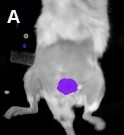
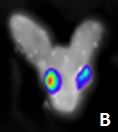 Intraoperative fluorescence device can detect the labeled scFv in cell culture, and then follow the biodistribution of the labeled scFv after intravenous injection into mice (Figure C) and locates the labeled scFv into the tumor on the prostates excised (Fig D). Molecular tomography fluorescence provides a quantitative picture of the labeled labeled scFv in in vivo mice’s prostate tumors (Figure E). These results were validated by imaging a probe labeled scFv not recognizing PSMA and histologically.
Intraoperative fluorescence device can detect the labeled scFv in cell culture, and then follow the biodistribution of the labeled scFv after intravenous injection into mice (Figure C) and locates the labeled scFv into the tumor on the prostates excised (Fig D). Molecular tomography fluorescence provides a quantitative picture of the labeled labeled scFv in in vivo mice’s prostate tumors (Figure E). These results were validated by imaging a probe labeled scFv not recognizing PSMA and histologically.
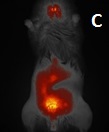
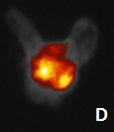
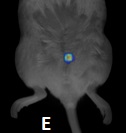 These results are the first of a draft of a bimodal ultrasound / fluorescence tomography imaging device and a probe specific for image-guided cancer prostate biopsies in humans (Project ANR- Bitum & Labex TRAIL). Mazzocco C, Fracasso G, Germain-Genevois C, Dugot-Senant N, Figini M, Colombatti M, Grenier N & Couillaud F (2016). In vivo imaging of prostate cancer using an anti-PSMA scFv fragment as a probe. Scientific Reports 6, 23314.
These results are the first of a draft of a bimodal ultrasound / fluorescence tomography imaging device and a probe specific for image-guided cancer prostate biopsies in humans (Project ANR- Bitum & Labex TRAIL). Mazzocco C, Fracasso G, Germain-Genevois C, Dugot-Senant N, Figini M, Colombatti M, Grenier N & Couillaud F (2016). In vivo imaging of prostate cancer using an anti-PSMA scFv fragment as a probe. Scientific Reports 6, 23314.
 FLI
FLI
